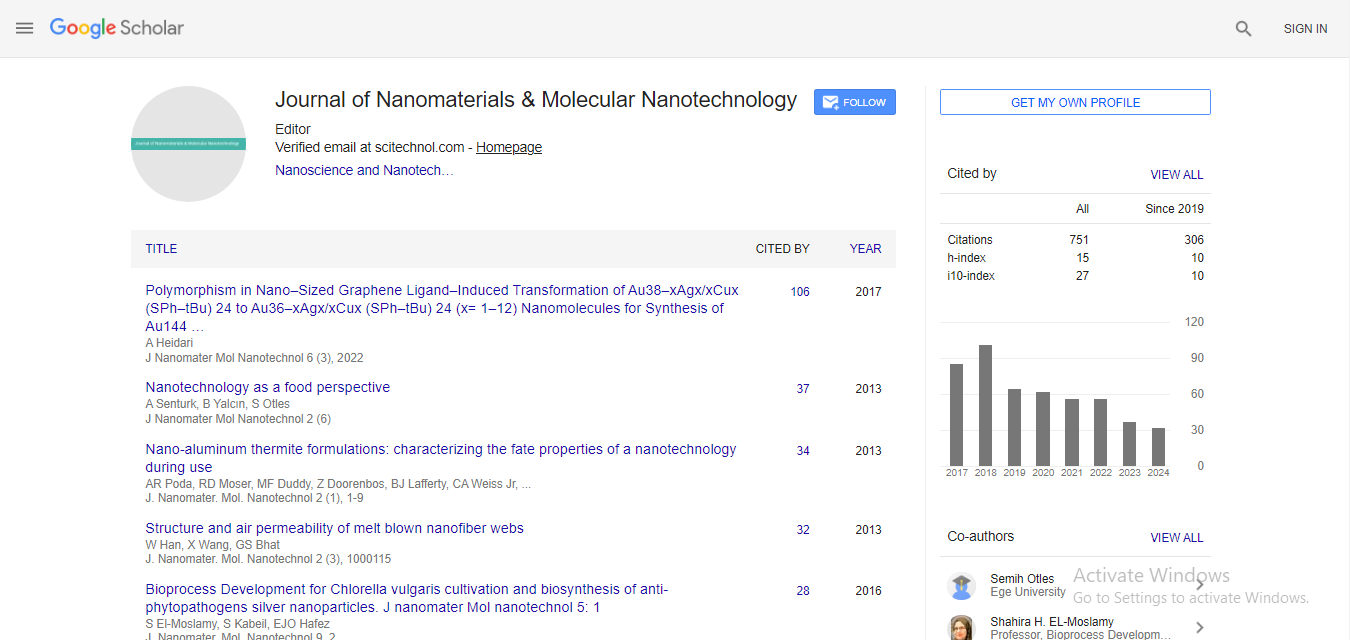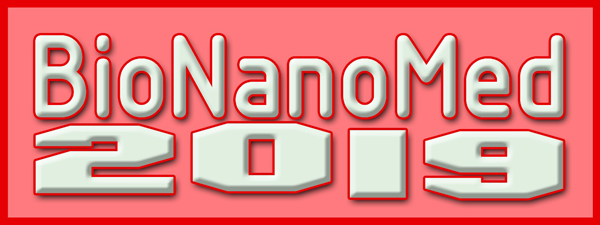Editorial, J Nanomater Mol Nanotechnol Vol: 6 Issue: 3
Polymorphism in Nano-Sized Graphene Ligand-Induced Transformation of Au38-xAgx/xCux(SPh-tBu)24 to Au36-xAgx/xCux(SPh-tBu)24 (x=1-12) Nanomolecules for Synthesis of Au144-xAgx/xCux[(SR)60,(SC4)60, (SC6)60, (SC12)60,(PET)60, (p-MBA)60, (F)60, (Cl)60,(Br)60, (I)60, (At)60, (Uus)60 and (SC6H13)60] Nano
Alireza Heidari*
Faculty of Chemistry, California South University, 14731 Comet St. Irvine, CA 92604, USA
*Corresponding Author : Alireza Heidari
Faculty of Chemistry, California South University, 14731 Comet St. Irvine, CA 92604, USA
E-mail: Scholar.Researcher.Scientist@gmail.com
Received: May 24, 2017 Accepted: May 25, 2017 Published: May 30, 2017
Citation: Heidari A (2017) Polymorphism in Nano-Sized Graphene Ligand-Induced Transformation of Au38-xAgx/ xCux(SPh-tBu)24 to Au36-xAgx/xCux(SPh-tBu)24 (x=1-12) Nanomolecules for Synthesis of Au144-xAgx/xCux[(SR)60, (SC4)60, (SC6)60, (SC12)60, (PET)60, (p-MBA)60, (F)60, (Cl)60, (Br)60, (I)60, (At)60, (Uus)60 and (SC6H13)60] Nano Clusters as Anti-Cancer Nano Drugs. J Nanomater Mol Nanotechnol 6:3. doi: 10.4172/2324-8777.1000e109
Editorial
Polymorphism of Nano-sized graphene ligands has been previously achieved by functionalizing the Nano-sized graphene ligands with various organic functional groups [1-5]. The grafting of anti-cancer Nano drugs having amine and alcohol moieties to the Nano-sized graphene ligands were attained by initially produced acyl chloride at carboxylic groups’ sites in Nano-sized graphene ligands which subsequently mixed with chemotherapeutic agents to afford the relevant amide and ester, respectively. In medicinal and pharmaceutical aspects of this editorial, it can be considered as new method for potential anti-cancer Nano drugs delivery by preparing several pastes that can be laid on the skin like a label and also through polymorphism in Nano-sized graphene ligandinduced transformation of Au38-xAgx/xCux(SPh-tBu)24 to Au36-xAgx/ xCux(SPh–tBu)24 (x=1-12) nanomolecules for synthesis of Au144-xAgx/ xCux[(SR)60, (SC4)60, (SC6)60, (SC12)60, (PET)60, (p-MBA)60, (F)60, (Cl)60, (Br)60, (I)60, (At)60, (Uus)60 and (SC6H13)60] Nano clusters as anticancer Nano drugs. Hydrolysis reaction can be achieved according to the skin’s pH and anti-cancer Nano drugs can be absorbed through the skin, along times when the paste is attached on skin. This process; therefore, makes it easier for anti-cancer Nano drugs administering of patients to get their medications through long periods. The problem usually associated with oral and injection of anti–cancer Nano drugs can be resolved using this method.
Our main objective is to develop strategies to exploit the photo-, electro-, and thermal-chemical reactions of these systems to severe as probes to aid in our basic understanding of the mechanistic factors that control molecular interactions and organic reactions at organized monolayer interfaces. Also, the development of new and selective ways of adding or removing functionality to these monolayers is another part of our ongoing efforts. In the present editorial, we have synthesized Au144-xAgx/xCux[(SR)60, (SC4)60, (SC6)60, (SC12)60, (PET)60, (p-MBA)60, (F)60, (Cl)60, (Br)60, (I)60, (At)60, (Uus)60 and (SC6H13)60] Nano clusters as anti-cancer Nano drugs and incorporated them onto the surface of gold nanoparticles through the place-exchange reaction. Then, the interfacial reactions of the anchored aldehyde terminus with various nucleophiles have been investigated in some details. Our preliminary results reveal an easy reaction of aldehyde terminus of the organic modified gold nanoparticle with the nucleophiles like aniline, leading to a covalent attachment of the nucleophilic species to the nanoparticle surface.
However, cancer remains one of the most important diseases of human with over half of the world population at risk of infection. It affects mainly those living in tropical and subtropical areas with an incidence of 500 million cases per year globally. Every year 300-500 million people suffer from acute cancer and 0.5-2.5 million die from this disease. Over the years polymorphism in Nano-sized graphene ligandinduced transformation of Au38-xAgx/xCux(SPh-tBu)24 to Au36-xAgx/ xCux(SPh-tBu)24 (x=1-12) nanomolecules has remained the anti–cancer Nano drugs of choice for cancer enzymotherapy, immunotherapy, chemotherapy, radiotherapy, hormone therapy and targeted therapy because of its low toxicity and cheapness. In continuation of our recent interests in the synthesis and chemistry of Nano-sized graphene ligands, synthesis of Au144-xAgx/xCux[(SR)60, (SC4)60, (SC6)60, (SC12)60, (PET)60, (p-MBA)60, (F)60, (Cl)60, (Br)60, (I)60, (At)60, (Uus)60 and (SC6H13)60] Nano clusters as anti–cancer Nano agents was studied. In this approach, polymorphism in Nano-sized graphene ligand–induced transformation of Au38- xAgx/xCux(SPh-tBu)24 to Au36-xAgx/xCux(SPh-tBu)24 (x=1-12) nanomolecules and followed by synthesis of Au144-xAgx/xCux[(SR)60, (SC4)60, (SC6)60, (SC12)60, (PET)60, (p-MBA)60, (F)60, (Cl)60, (Br)60, (I)60, (At)60, (Uus)60 and (SC6H13)60] Nano clusters as anti-cancer Nano drugs through cyclization reaction.
References
- Hillman DR, Eastwood PR, Vanderveken OM (2017) Chapter 148 - Anesthesia in Upper Airway Surgery for Obstructive Sleep Apnea, In Principles and Practice of Sleep Medicine (6 Edtn), edited by Meir Kryger, Thomas Roth and William C. Dement, Elsevier 1458-1462.
- Lazic K, Petrovic J, Ciric J, Kalauzi A, Saponjic J (2017) REM sleep disorder following general anesthesia in rats. Physiology & Behavior 168: 41-54.
- Weller JQ, Konczalla J, Duetzmann S, Jaeger CF, Strouhal U, et al. (2017) General Anesthesia Versus Local Anesthesia in Stereotactic Biopsies of Brain Lesions: A Prospective Randomized Study. World Neurosurgery 97: 16-20.
- Dubovoy T, Shanks AM, Devine S, Kheterpal S (2017) Frequency of inadequate neuromuscular blockade during general anesthesia. J Clinical Anesthesia 36: 16-20.
- Lumb AB (2017) Chapter 20 - Anaesthesia, In Nunn's Applied Respiratory Physiology (8th edtn), Elsevier 291-318.
 Spanish
Spanish  Chinese
Chinese  Russian
Russian  German
German  French
French  Japanese
Japanese  Portuguese
Portuguese  Hindi
Hindi 



